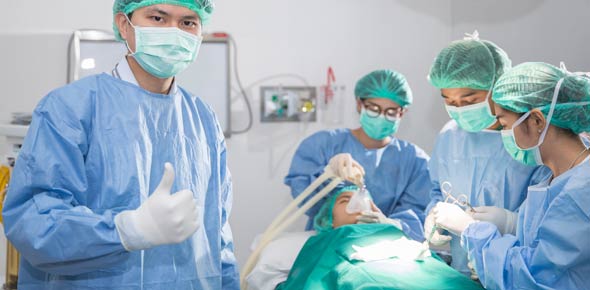A laboratory procedure useful in classifying bacteria using a staining...
A severe allergic raction possible resulting is death is called
A bacteria found in the intestinal tract is
The small, sensitive structure of the female homologous to the male...
The bacteria highly resistant to sterilization and disinfection is
Removal of contaminated debris from a wound is called
The perineum is
Keloids are
The kidneys ar positioned
Ova are swept into the fallopian tubes by small, fringelike extensions...
The inner lining of the uterus is called the
The loose skin covering the glans penis like a sheath is called the
A fulminating infection arising from necrotic tissue and spreading...
The smooth, triangular area at the bottom of the bladder that contains...
Herpes simplex is commonly called
Oxygen-dependent bacteria are said to be
The digestive passageway that begins at the pharynx and terminates in...
The function of the molar teeth is to
A lack of voluntary control over micturition is called
Urine empties from the bladder through a tube called the
Tiny blood essels that permeate and nourish tissue are called
The appendix is attached to the
Staphylococcus aureus would most likely be transmitted by
The primary function of the gallbladder is
Microbial death occurs when an organism is
The salivary glands located under the tongue are the
The yellow tinge in the skin symptomatic of obstructivejaundice is...
Rodlike shaped bacteria are identified microscopically as
A procedure used to remove damaged tissue that provides growth...
Which structure lies retroperitoneally?
The body's first line of defense against the invasion of pathogens...
The s-shaped bend in the lower colon is called the
Passage of fluid through a cell membrane is called
The large central portion of the stomach is called the
The spleen is located
A bacterial pathogen most frequently invading damaged skin is
Fertilization occurs in the
The wall or partition dividing the heart into right and left sides is...
The inner lining of the heart, composed of smooth, delicate membrane,...
In a male, the structure surrounding the entrance to the urethra just...
All of the following descriptors refer to the inflammatory process...
The space caused by separation of wound edges is called
Clostridium tetani causes
The reabsorption of water and electrolytes is the main function of the
Inflammation is characterized by pain, redness, heat, swelling, and...
The clinical syndrome characterized by microbial invasion of the...
The area in the duodenum where the common bile duct and the pancreatic...
Which bacteria is commonly found in soil?
The English surgeon who began the age of chemical control of the...
The point at which the esophagus penetrates the diaphragm is called...
Bacteriostatic means
A cicatrix is
Which structure is also known as the "fatty apron"?
The portion of small intestine that receives secretions from the...
Which type of would would favor the development of gas gangrene?
Blood is supplied to the kidney by means of the renal artery, which...
What immune protection is available to the fetus?
The distal end of the penis is slightly enlarged and is called the
The destruction of bacteria by white cells during the inflammatory...
The liver has
A CDC guideline that addressed the care of "sharps" includes...
The heart valve that closes at the time the right ventricle begins...
The burn classification that is characterized by a dry, pearly white,...
If tissue is approximated too tightly it can cause
When the gallbladder contracts, bile is ejected into the
The substance that unites with thrombin to form fibrin, the basic...
The muscle serving as a valve to prevent regurgitation of food from...
Urine is transported along the ureters to the bladder by
The first portion of the large intestine is the
Tensile strength of a wound refers to
The contractions of the heart are synchronized and regulated by the...
What organism is responsible for a boil?
The outer layer of the kidney is known as the
Adenoids are also called
Mumps occur in the
A wound that is infected or one in which there is excessive loss of...
The kidney structure that filters blood, returns useful substances to...
The head of the pancreas is located
The region of the stomach that connects to the duodenum is the
The mesentery is
The descending aorta terminates at the level of the fourth lumbar...
The indentation in the kidney through which all structures must pass...
The organism most frequently found in burns is
Gas gangrene is caused by
The tubes or cuplike extensions that project from the renal pelvis are...
The bacteria that causes rheumatic fever is
OSHA is a govenmental regulating agency whose aim is to
The glomerulus is a
The ligament that attaches the ovaries to the pelvic wall is the
The supporting structure of the male reproductive system is the
Which structure is not a portion of the male urethra?
All of the following are parts of the lymphatic system EXCEPT the
The common bile duct is the union of the
The sphincter at the junction of the small and large intestines is the
A toxoid is
The terminal portion of the large intestine is the
The long, coiled tube in which sperm mature is the
Inflammatory exudate that is thick and yellow is termed
The portion of the male urethra that passes through the pelvic floor...
This structure stores sperm and propels them toward the urethra during...
















